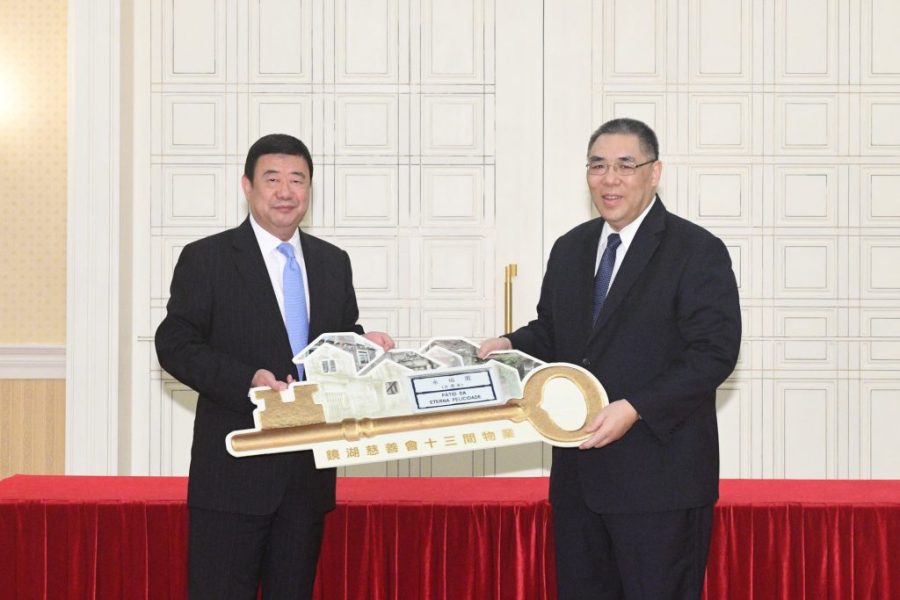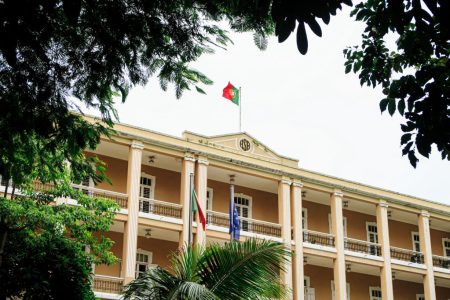The Kiang Wu Hospital Charitable Association (KWHCA) Monday donated 13 properties in Pátio da Eterna Felicidade (“Courtyard of Eternal Happiness”) and Rua da Tercena to the government, Cultural Affairs Bureau (IC) Director Mok Ian Ian said, adding that the properties would be developed into a cultural and leisure area in conjunction with surrounding tourist spots in the near future.
Three representatives from the government and the association signed an agreement on the property transfer at Government Headquarters Monday, after which Chief Executive Fernando Chui Sai On received a symbolic key from KWHCA Chairman Liu Chak Wan, representing the 13 donated properties being officially handed over to the government.
Mok made the remarks while speaking to reporters after the signing ceremony.
Mok pointed out her bureau will be responsible for the use of the 13 properties and their space planning, adding that the structural repairs of the properties and environmental assessments would be done first once the bureau received all the buildings, after which a space analysis for the buildings would be carried out.
The 13 properties are planned to be used in three major aspects, namely for cultural heritage conservation and culture and heritage promotion activities, and as exhibition and performance space for literary arts, according to Mok.
For example, the preliminary plan is to showcase the history of Pátio da Eterna Felicidade and set up a cultural performance and exhibition venue, Mok pointed out, adding that the bureau also planned “to promote our historic city by oral storytelling.”
The 13 edifices are located near the Ruins of St. Paul’s and Rua dos Ervanários, which is a good location near the central area of the city, according to Mok. She added that the bureau will renovate the buildings and develop them into a culture and leisure area in connection with surrounding tourist spots.
Mok also said that she hoped to conduct a cultural heritage assessment on the buildings in Pátio da Eterna Felicidade but needed to set up an overall development plan first.
The 13 donated properties are part of the UNESCO World Heritage-listed Historic Centre of Macau area, according to a statement by the Macau Government Information Bureau (GCS), which pointed at that the 13 buildings maintain the traditional Lingnan architectural features in a total construction area of 2,184 square metres, all of which are in good condition.
The Historic Centre of Macau is made up of two separate core zones in the city centre on the peninsula. Each core zone is surrounded by a buffer zone.
Lingnan architecture tends to favour pale colours such as green and white, avoids circular structures and adopts large numbers of relief carvings and sculptures, as well as having many open structures like balconies and verandas, according to Wikipedia, adding that the Lingnan building styles are still relatively common in some areas of Hong Kong and Macau.
Responding to a reporter’s question about the Guia Lighthouse Protection Group having sent a petition to UNESCO in Paris laying out its concerns about a high-rise residential building project impacting the view of the World Heritage-protected Guia Lighthouse, Mok said the government had set up a maximum building construction height in the areas surrounding the Guia Lighthouse in 2008.
New building projects near the Guia Lighthouse area are not allowed to exceed 52.5 metres in height but the government still allowed the high-rise residential building project near Guia Hill to keep its existing 81.32 metres height when it was built before 2008, according to the local media reports.
Mok noted that the project was under construction at that time.
Therefore, according to Mok, the bureau has no objection to keeping the existing height of the unfinished building but has required the project developer to do a good job on the project’s façade design and interior decoration.
Mok also pointed out that the bureau has submitted its suggestions to the State Administration of Cultural Heritage and transferred the bureau’s suggestions to the UNESCO World Heritage Centre, adding that the centre didn’t oppose the existing height of the unfinished building project.
The unfinished building project is an initially 126-metre residential tower project “cut down” by an executive order. It is located on Calçada do Gaio near Guia Hill. (Macaunews)






